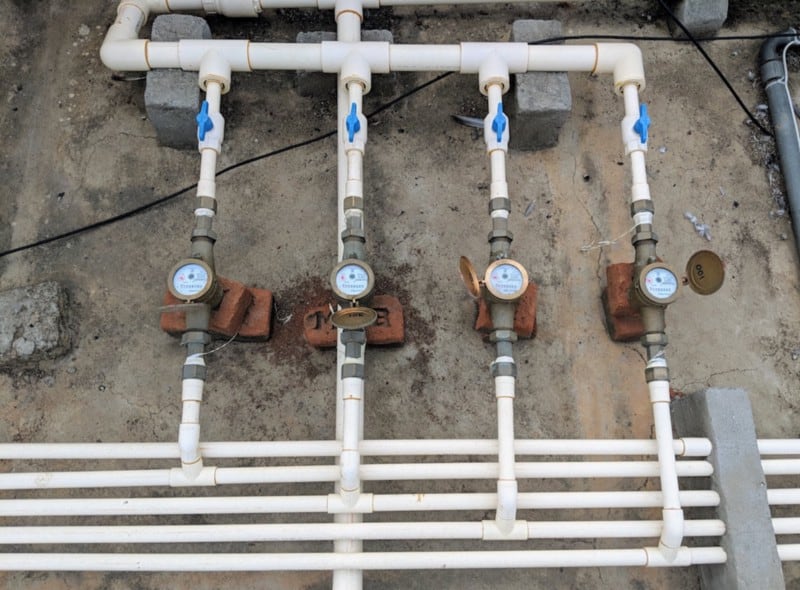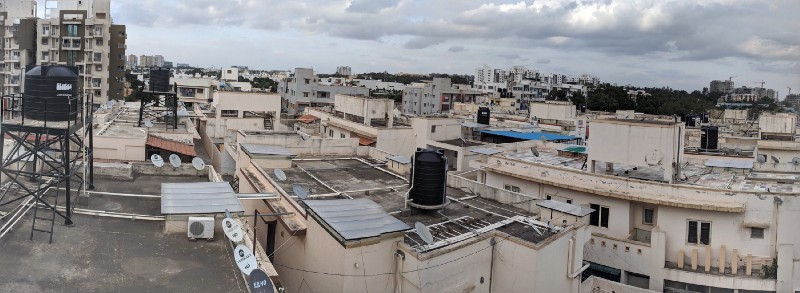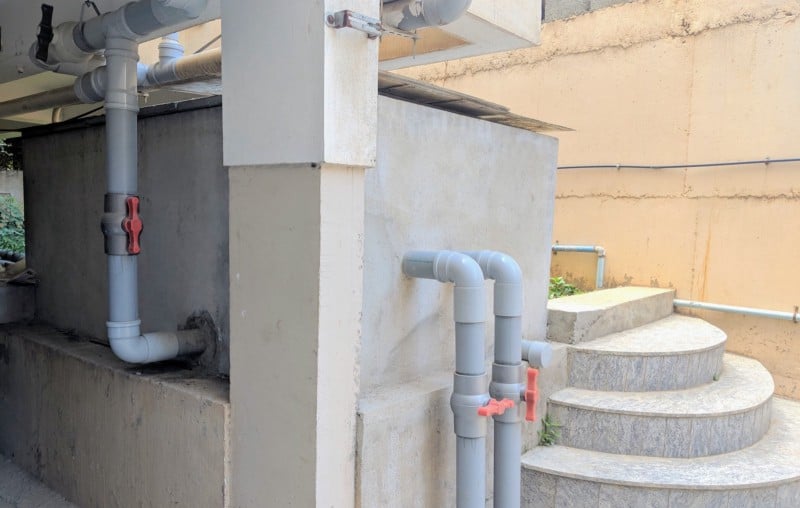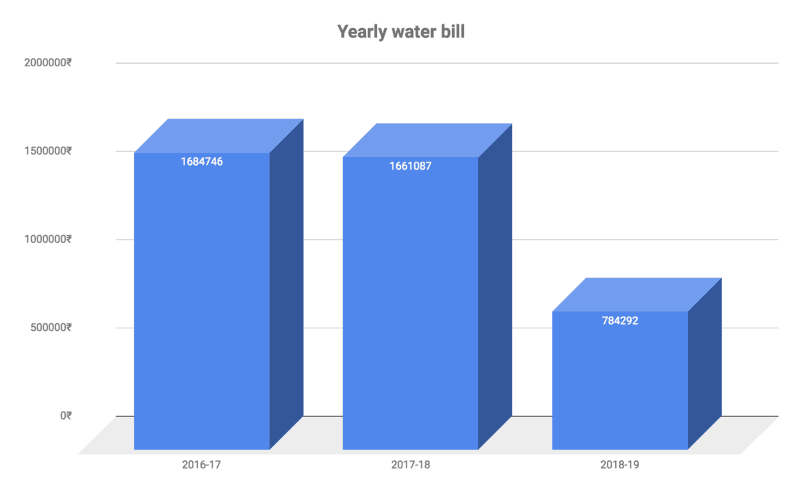In the last few years, most borewells in our apartment in east Bengaluru, off Outer Ring Road, went dry with the depletion of groundwater levels. Our water expenses skyrocketed and we had to regularly keep increasing maintenance charges to cover the cost.
We are a mid-range 10-year-old apartment community with 171 flats spread across four blocks, having a swimming pool, a small clubhouse and a gym.
Early last year, we implemented three measures to reduce water use. The outcome was that our water use and costs reduced by 52 percent in a year!

Water expenses kept increasing over the years
Water meters for accountability
Most apartments don’t come with water flow meters for individual flats; so was the case with our apartment. But, we figured the only way to hold people accountable was by installing meters for each flat.
As there was no single entry point of water inlets to individual flats, the flow meter installation was not easy. The two-bedroom flats had three separate water inlets — one for kitchen, and two for bathrooms. The builder had got the plumbing done in a way that pipes were drawn from the nearest point in the duct, to cut cost. So we had two options:
- Install individual water flow meters for every inlet to a flat.
- Connect all three inlets to a single point on the terrace, and install a single water flow meter there.
The first option needed less work, but getting meter readings from inside the ducts every month was practically impossible. Over time, the labour involved in meter readings would offset the savings as well. Even the cost of maintaining remotely-readable smart water flow meters would not be manageable over time.
So we narrowed down on the second option which required extensive plumbing work.

Water flow meters installed on the terrace. Pic: Amal Padmanabhan
Reusing treated water
STP water reuse was another major item on our agenda to reduce water wastage. We already had a well-functioning Sewage Treatment Plant (STP), managed by a dependable service provider.
The challenge was to use treated water from the STP in flush tanks, without compromising on health and comfort. The treated water had to have parameters within the limits prescribed by authorities, without bad odour or colour.
Connecting treated water to flush tanks was also a lot of work. But we decided not to install water flow meters to measure consumption of treated water by individual flats, to save on the cost of material and labour. This was a well-thought-out decision since treated water would be in excess of our requirement.
To route treated water, we first installed two large tanks over an apartment block that was close to the STP. These tanks would supply water to smaller tanks installed on other apartment blocks; the smaller tanks in turn would be connected to the flush tanks in individual flats. The work was done after identifying safe points on the terrace with the help of civil engineers, to ensure that the water tanks would not pose any danger to the buildings.

Two big black Sintex plastic tanks (to the left) are placed on an elevated metal fabrication, which feed the smaller Sintex tanks (to the right). Pic: Amal Padmanabhan
From the STP, treated water gets pumped to the larger tanks, which then feeds the smaller tanks by gravity. Float and ball valves are installed in the lower tanks to automatically cut off excess supply and prevent overflow. The smaller tank then supplies water to all flush tanks and the garden.
Rainwater harvesting from all terraces
Bengaluru receives a lot of rain even during the summer. We were sure of saving water if we used rainwater to recharge our sumps and borewells. We connected all our open terraces (which we clean every fortnight) to two separate filters. We then connected the filtered water to our underground sumps and borewell recharge points. This saves us from buying water on many occasions even when the rains were for short durations, like less than an hour.

Rainwater filter. Pic: Amal Padmanabhan
Expenses incurred
The entire project was done in-house without involving contractors, and using only high quality products. The overall cost of works is described here.
Water flow meter — Rs 24,06,850
- 25mm Dashmesh B class meter
- Astral SDR 11 CPVC pipes
- Astral plumbing fittings
STP water reuse — Rs 22,81,927
- Astral SDR 13.5 CPVC
- Astral plumbing fittings
- Sintex plastic water tanks
- Metal and concrete tank mounts
- STP additional tank and replenishment
Rainwater harvesting — Rs 5,00,000
- Concrete tank for filters
- PVC pipes connecting terrace to tank and sump
- Filtering materials
Did it work? How much did we save?
Our water consumption and expenses went down drastically. It was surprising to see average savings of 52 percent in a year. In 2016–17 and 2017–18, we had no water metering, enough rainwater collection or STP water reuse. After implementing these measures, in 2018-19, our water costs came down to Rs 7.8 lakhs, from over Rs 16 lakhs in previous years.

Individual flats to recover cost in 30 months
Since the flow meter is used for water billing, individual flats that save water are highly benefited. Since water billing is separated from maintenance charges now, we have reduced maintenance charges by 25 paise per sq ft of apartment, per month. The overall savings of individual flats is shown in the chart below.

In the five months after project completion, between April and August, each apartment saved Rs 5213 on average. In comparison, to implement the project, each flat had invested Rs 30,343. This means we can expect to break even within just 30 months!
[Amal Padmanabhan can be contacted at amal.parambath@gmail.com]
A very welcome move…
Bangalore can easily tide over its water crisis only if every apartment complex adopts measures and methods described by Mr. Amal Padmanabha …
Excellent Article to Celebrate WORLD WATER DAY Today- MARCH 22
Good participatory effort. Worth emulation
Good work by enthousiast Office Bearers of Association. Apriciate the work done by them.
Hi Amal,
Nice article! Can you provide your contact. We are also planning for our apartment. Need advise from you for rain water harvesting.
This is lovely and should be emulated IF POSSIBLE across the existing societies and also on the under construction flats.
BUT i am not clear on how the ROI for each flat has been calculated. can some one give me a proper break down of how 25 paise reduction translates to 5k savings over 5 months, all the while when the resident is also paying for the water additionally.
Kudos. Great initiative. And precise explanation.
This concept can be taken up by all apartment builders for implementing from design stage itself.
super sir, We have the same problem. We already have STP plant , we let out a very clean water. sIR NEED YOUR HELP.pLEASE contact me charmachem@gmail.com
Reused water STP chemicals are leading causing of cancer and other ailments. So hope they don’t re-use the same water again again you may save few lakhs BUT you and your loved ones will lose your lives..
Really good group efforts. Not only individual cost savings water saving gifting guidance to the world.
Can you give a break up of saving for each measure,is it possible roughly in percentage?for ex water meter saved 50% and stp recycling saved 25% and rain water saved 25% similar calculation
Can you help me with the contact details of water metering solutions company.
Why does it cost 22 lakhs for 360 flow meters ?? Where each Meyer costs around 2k…
Not only meters, plumbing also included.
They went with option 1 , single meter with extensive plumbing
I appreciate all the efforts and thoughts. But I will point that return on investment for meters will be very poor. In fact waste of money, Added labor to get meter readings every month. Effective use of STP and rain water harvesting would result in max saving.
When there is no scope for ingestion or skin contact of treated STP water,how can there be cancer risk.
Will thank you for more elucidation.
This needs more share
My appreciation for the Community for implementing nearly impossible tasks in an Association of more than 170 flats. Bravos, please keep doing such socially relevant activities. R Jambunathan
Amal, can we get in touch to understand a few things..
Rishav, please reach out to me at Twitter handle amalpadmanabhan
Twitter – amalpadmanabhan
Please reach out if you need any data.
Thomas, the ROI is not about 25 paisa. It’s about reduction in water cost by 52%. When it’s not metered a lot of people pay for other careless users water wastage. It stops after water meter. Along with that we connected flush tanks to STP water which saves quite a bit as well.
Hi Chandran, please reach out at Twitter handle amalpadmanabhan.
This is a fine example of responsible human beings. Making most of the available resources increases the chances of survival. Kudos to all the team members who did this. Hopefully people will take cue from it and start such projects more.
In my opinion I would request you to spread this to your neighboring societies as well. Thank you for sharing this!
Good team work with cooperation from all the residents.
Great thought and effort for well being. Kudos to you guys.
This kind of Water metering system was well thought in advance and being followed by some of apartments which saves huge water consumption.
These kind of measures should be set as criteria prior to approval of Buildings.
I really appreciate your efforts in conserving water & sharing the above. I am interested in installing a water meter for a 6 apt building. Can please share the details of the agency which installed water meter for you. Thanks.
We did that ourselves Raman.
Mr Padmanabhan, is water charged from zero consumption or is there a minimum free quota Please? I don’t have Twitter how else can I speak to you
Well done sir, excellent arrangements. Hats up to all the persons involved.
A laudable effort. If all (ie most of) citizens adopt proper measures in their houses, the consumption of water will come down. Rain water harvesting has to be taken up in earnest. We are already staring at a water crisis but our netas are blissfully unaware. Educating the public is needed.
Hello team greens. Excellent work keep it up. As I’m plumbing and sanitary system consultant. Kindly note small suggestion from my end.Pls provide flow aerators for shower rose and for kitchen sink bib tap you can save some more water. Normal flow aerators tap will discharge 12 to 18 LPM. You can regulate this flow to 4 to 6 LPm. It will cost nominal charges. Big savings. Pls go for it.
Very Good. Sometimes problem faced is that all residents do not agree on initial investments.
Good article about water saving , really each apparent in Bangalore check possible ways to save water otherwise Bangalore will India’s capetown for water crisis soon.
Good initiatives and post implementation tracking of benefits is also important.
Many apartments have RO plant for all water use. RO plant rejects 50% water. Authorities should not allow such RO. It should be for drinking only.
I have 1 more technique for water metering system. I am ready to help you.
Pls ellaborate
Excellent work and great planning & execution. All natural resources must be wisely used. It is social responsibility. One of IISc professor has such great ideas as well.